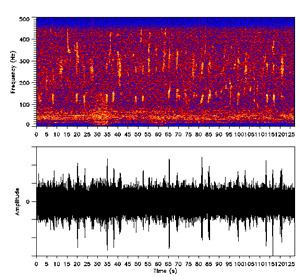 | ||
Acoustic ecology, sometimes called ecoacoustics or soundscape studies, is a discipline studying the relationship, mediated through sound, between human beings and their environment. Acoustic ecology studies started in the late 1960s with R. Murray Schafer and his team at Simon Fraser University (Vancouver, British Columbia, Canada) as part of the World Soundscape Project. The original WSP team included Barry Truax and Hildegard Westerkamp, Bruce Davies and Peter Huse, among others. The first study produced by the WSP was titled The Vancouver Soundscape. The interest in this area grew enormously after this pioneer and innovative study and the area of acoustic ecology raised the interest of researchers and artists all over the world. In 1993, the members of the by now large and active international acoustic ecology community formed the World Forum of Acoustic Ecology.
Contents
Every three years since the WFAE's founding at Banff, Canada in 1993, an international symposium has taken place. Stockholm, Amsterdam, Devon, Peterborough, and Melbourne followed. In November 2006, the WFAE meeting took place in Hirosaki, Japan. Koli, Finland, was the meeting place of the latest WFAE world conference.
From its roots in the sonic sociology and radio art of Schafer and his colleagues, acoustic ecology has found expression in many different fields. While most have taken some inspiration from Schafer's writings, in recent years there have also been healthy divergences from the initial ideas. Among the expanded expressions of acoustic ecology are increasing attention to the sonic impacts of road and airport construction, widespread networks of "phonographers" exploring the world through sound, the broadening of bioacoustics (the use of sound by animals) to consider the subjective and objective responses of animals to human noise, including increasing use of the idea of "acoustic ecology" in the literature, and a popular in the effects of human noise on animals, with ocean noise capturing the most attention. Acoustic ecology finds expression in many different fields, including niches as unique as historical soundscapes and psychosonography.
"Dominion" by Barry Truax
"Dominion" takes listeners on an acoustic journey across Canada. The work begins with the firing of the Noon Gun in St. John's harbour in Newfoundland and continues westward, recording sounds such as the Peace Tower bell in Ottawa and the O Canada Horn in Vancouver, along the way. A 12-piece orchestra, representing the 10 provinces and then two territories, carries listeners through the work, along with the whistle of a Canadian Pacific Railway train, representing the railroad that first connected Canada over a century ago.
Acoustic Ecological Archeology
Marc E. Moglen (2007) recreated pre-historical Soundscapes (Acoustic Ecology) at University of California, Berkeley's Department of Anthropology, combining compositional techniques with site recordings for a non-diegetic piece in the virtual world of Second Life, on "Okapi Island". At the Center for New Media the acoustic ecological setting of the former jazz scene in Oakland, CA was developed for a virtual world setting.
"Soundmarks of Canada" by Peter Huse
"A composition recreating the acoustic profile of community sounds unique to Canadian locales, coast to coast". Source: Soundscapes of Canada.
